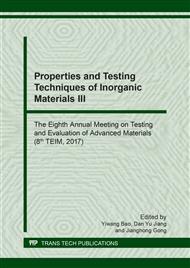p.36
p.41
p.46
p.52
p.59
p.64
p.69
p.75
p.87
Test of Corrosion Resistance of Heat Insulating Materials to Cryolite Vapor
Abstract:
Heating insulating materials were often eroded by cryolite vapor when they were used outside the wall of energy saving aluminum electrolysis cell. Insulating effect of aluminum electrolytic cell became worse with the time of extension. According to service environment of the aluminum electrolytic cell, a set of test methods was put forward. The physical properties, phase compositions and microstructures of the heating insulating materials under the different test conditions were studied by self-made test device. The results showed that test and characterization the corrosion resistance to cryolite vapor was of great significance for evaluating the performance decline and exploring the mechanism of corrosion resistance in the service process of materials. It provided a guidance to develop and choose the appropriate insulating materials.
Info:
Periodical:
Pages:
59-63
Citation:
Online since:
April 2018
Authors:
Keywords:
Price:
Сopyright:
© 2018 Trans Tech Publications Ltd. All Rights Reserved
Share:
Citation:


